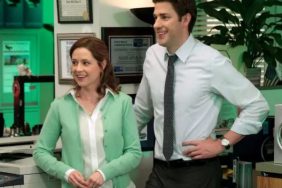I’m used to seeing Willem Dafoe with leeches on his flesh, or fighting Michael Pare in a post-apocalyptic wasteland, or in the process of rectifying certain inequities in Spider-Man. Or at least giving a sermon on the mount, but sitting across from him in a hotel room in Arizona, that was new. We were sitting down to talk about his role in John Carter, Andrew Stanton’s mostly live-action adaptation of Edgar Rice Burroughs’ classic pulp novels.
In the film, Dafoe plays a giant four-armed alien named Tars Tarkas. On the set, he was running around on stilts with dots on his face. In the hotel, he was talking about making a movie in lifts, why he loves movies about weirdos, and of course that time Madonna dripped hot candle wax on his chest in Body of Evidence.
CraveOnline: It’s probably something you don’t hear very often, but I’ve been a fan of yours since Body of Evidence.
Willem Dafoe: Wow! Okay…! [Laughs.]
It was the first film I ever saw you in, but then I went back. Candles were changed for me forever.
Me too. [Laughs.]
How was making John Carter different from making Body of Evidence?
Oh God! Uh… My co-stars were very different. [Laughs] But they both were topless!
So many of your films have a certain darkness to them. Do you gravitate to that…?
[Thinks for a long time.] I’m not sure I agree with you? But okay, for argument’s sake…
It’s a perception.
It is. I wouldn’t say a “darkness” as much as I think I’m interested in “marginal” characters? Because I think sometimes those stories told from people from the margins are the most interesting ones. And I get most excited by the poets, the lunatics, the crazy people, because every day in the papers and our lives, we’re dealing with the same people. So, the most interesting perspectives come from [the] disenfranchised. So I think that the fantasy, that trying to get a new view, a fresh view, and not a dead view, often comes from them. So those are the stories I’m attracted to.
Tell me about Tars Tarkas, for the people who don’t know.
Yeah, Tars Tarkas, he’s a nine-foot tall Martian warrior king. He’s the leader of a very primitive culture, basically nomadic, very warlike. He himself, privately, feels that the society’s in decline and something has to change. He’s concerned, but he can’t show that concern, because above all, strength and brutality is valued in this society. When John Carter comes, he sees the possibility for an ally to change to this, in his society.
It’s redundant, but of course it takes place on Mars. All the cultures there have a human element to them, but of course they’re very different in many respects. You said you weren’t a fan of the books before this?
Not a fan, I just didn’t know them.
But Andrew Stanton was a huge fan. He geeks out about them.
Huge.
How did introduce these concepts of the culture and Tars Tarkas to you…?
You know, it was show and tell because I came on board after… I’d say, toward the end of their casting process. So they had Taylor [Kitsch] and Lynn [Collins] already, and some of the other characters. And basically he told them the story, told me how he was going to do it… He was really insistent about playing the scenes, not leaving a lot up to the computer, you know, to invent them from thin air. It’s not like shooting against a green screen. He showed me the designs. He showed me these very beautiful renderings of some of the sets, some of the costumes, some of the characters. And when he showed a draft of who Tars Tarkas was, told me who he was, to his mind, and he said, “This is what I want you to do,” I thought, okay, cool!
Did he show you the stilts then, after you already agreed?
No! He told me about them [but] I didn’t know it until I arrived in London. Thark Camp.
How much time did you have to get used to those?
The stilts…? There was about a… I can’t remember, about a two-week prep? And that was basically to practice the stilts, practice some fighting, check some technical things, learn Thark [the language]. You know, basically do preparations, and then of course the shooting was quite long, and even though there was a lot of scenes I’m not in, I was around a lot, most of the time. So when I wasn’t shooting, I practiced on the stilts. My favorite thing to do, was to play catch on stilts. Because it’s interesting to, once I get to a certain level of comfort, to have another action besides the stilts, you know? Where you’re throwing, and you’re running to catch. It makes you much more free, because you aren’t so obsessed about your balance. You feel it. That was a good exercise.
Was this your first motion-capture performance?
Technically, I suppose, yes. I mean, I’ve been around certainly with Spider-Man, there were CGI elements, but most of the time… Yeah, I guess it was.
That’s still kind of a new concept. Did you get to experiment with that before you went on camera?
A little bit. A little bit. When we first… Like, when we did this Thark Camp, they set up this beautiful thing, where I think it was as much for them as it was for us, that we wore these suits with these contacts on it and they had a monitor up, and we could literally walk around and watch our nine-foot renderings. Not with any real definition…
You got a sense of how it was going to be.
Yeah! You’d go like this [gets up and gestures], and you’d see what that looked like [on the monitor]. So we got to play with that.
How did the four arms thing work? Were the other arms just CG? Did you have to do every motion twice?
I never had arms just hanging there. We only used for arms, of course, when there was “business.” You know, it’s not extensive, but there are a few gags where [speaks in Tark, gestures for John Carter to jump], he goes from this hand to this hand. Since I don’t want to go like this [gestures with wrong hands], because that screws up the animators. I go like this, and then you get a stunt man under here [his arms], my hand’s up here, going down to a stunt man’s hand. Because then we have four arms, and the animators have the proper spatial relationship. So sometimes you have a stunt man attached to you. [Laughs.]
You’ve worked under heavy makeup before. Count Orlok was a wonderful performance.
Great, thanks.
How is motion capture different? Because you can see yourself in the mirror, obviously you have the physical element, but here do you have to focus more?
Nah…
You’re the expert.
The truth is, once you accept the terms? [Whispers] – It’s no different from anything else. You’re playing the scenes the best you can.
I think people see that so many things around you [on set] are so much more abstract.
It’s not true. It’s not true, because my points of interest are… If I’m doing a seen with Carter, I’m looking at his eyes. I’m dealing with him. What’s happening out here, I feel, but it’s not the point of my concentration. So most of what I’m dealing with, when I’m playing these scenes, I can feel. [It’s] tangible. There’s very little abstraction. So the only thing that makes it different from a regular performance is you’ve got these things on you. You know, fundamentally it’s the same. It would be if you’re playing Hamlet, but someone puts a ball and chain on your leg. It’s a condition.






